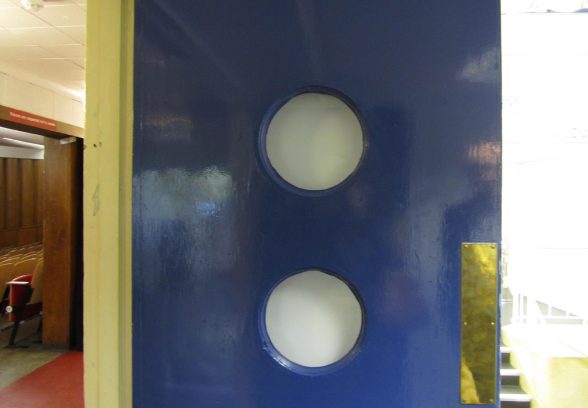This website uses cookies
This website uses cookies to enable it to function properly and to analyse how the website is used. Please click 'Close' to accept and continue using the website.






Colston Hall is well-known in Bristol as a city-centre entertainment venue, home to shows from stand-up comedy to classical concerts. Less celebrated, however, is the 1950s interior, still virtually unaltered inside its handsome Victorian shell. The hall, which is Grade II listed, has come to our attention due to modernisation plans that threaten to strip out the unique interior.
It was opened in July 1951 – two months after the Royal Festival Hall – as part of the local Festival of Britain celebrations in Bristol. The architect, J Nelson Meredith, was responsible for the City’s post-war rebuilding programme, and his redesign of the hall’s interior was praised at the time as one of the best of the Festival of Britain era. It was unveiled by the Duke of Gloucester at an inaugural concert by the Royal Philharmonic Orchestra, conducted by its founder, Sir Thomas Beecham.
The site, on a steep hill in the city centre, has a tragic history, and the current hall is the fourth to be built here. The first was designed by Bristol-based architects Foster and Wood in 1867. A fire thirty years later destroyed everything except the C19 façade, and a new ‘restored and re-fitted’ Colston Hall opened on the site in 1900. This in turn was reconstructed in 1936 (to the designs of C F W Dening) with reduced capacity, as audiences were dwindling. Just nine years later, in 1945, the hall was destroyed by fire for a second time – this time caused by a cigarette – leaving little or no trace of Dening’s work.
Meredith’s 1951 design – featuring bespoke acoustic panelling and a large canopy above the stage made from fibrous and in-situ plaster – was strongly influenced by acoustic requirements and the advice of Hope Bagenal at the Building Research Station, who also advised on the acoustics for the Grade I Royal Festival Hall, the Free Trade Hall in Manchester (1951, Grade II *, now demolished) and Fairfield Hall, Croydon (1962, unlisted). Colston Hall is the only one left with such a remarkable degree of intactness.
The auditorium still has its original light fittings and walls with chestnut veneer panelling and strips and dado of Mansonia (a hardwood from West Africa). The use of such materials was notable at a time of post-war austerity. The front of the auditorium floor has a polished strip surface of Muhuhu (another African hardwood), so that the hall could be used for dancing or exhibitions, and a bespoke boxing ring was designed to fit partly on the platform and partly on the auditorium floor – national boxing competitions were held here until the mid-1990s.
The original chipboard acoustic tiles with polished hardwood edges of red Meranti still line the walls above the balcony, while the insulated doors with port-hole windows remain in place, as do the distinctive ceiling light fittings. The low-relief decorative motifs by Ernest Pascoe fitted to the balcony sides are another example of the quality of the architectural detailing. The only permanent alteration to the hall since 1951 has been a stage extension and replacement seating.
The Bristol Music Trust, which runs the hall, says its rebuilding plans are justified by general wear and tear, acoustic issues, cramped backstage areas, and an inflexible stage. In our view, a sympathetic restoration and refurbishment could address the back-of-house problems and other issues without rebuilding the main auditorium, and we would welcome a less radical approach.
The owners are still seeking funds for their scheme (which is advertised on their website) and a formal planning application is still in the pipeline. We hope the Trust will proceed with caution; we think Colston Hall should be celebrated as a unique survivor of Bristol’s contribution to the Festival of Britain.
Henrietta Billings

Become a C20 member today and help save our modern design heritage.